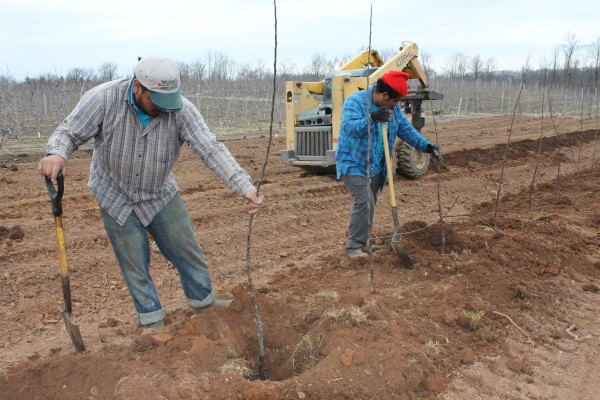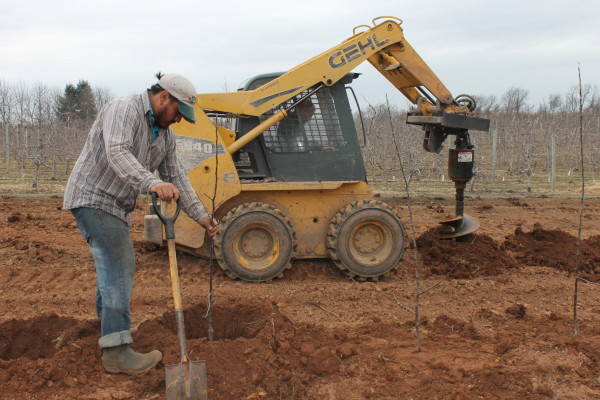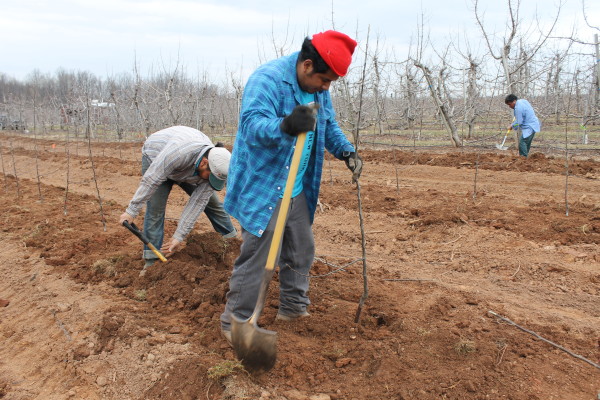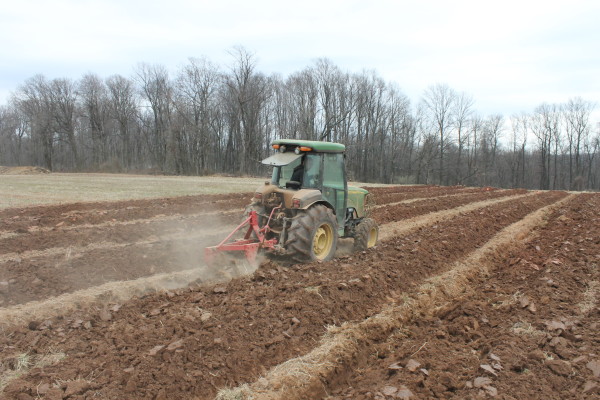It is fruit tree planting time at the orchard right now. Each spring, we plant 2,000- 4,000 fruit trees, replacing three to four acres of 18-20 year-old trees that are no longer producing as fruitfully. We have eighty acres of fruit trees, so over the course of 20 years, we replace our entire acreage.
This spring, we are especially anxious to get the trees in the ground because we are starting a week or two later than some years. With the late thaw followed by some rain, the ground was not yet suitable. Muddy soil does not provide enough oxygen around the roots. While we do want the ground to be sufficiently moist, we had to wait for the muddy soil to drain.
We also look forward to planting time because we have been planning for these trees so far in advance. Three years ago, we ordered these fruit trees from a nursery, and soon after we placed the order, the nursery began growing “root stock” for us. This means that first, they plant a small cutting, about the size of a small finger, that grows for one year. Next, they take a cutting– known as scion wood– from a specific tree variety, for instance, a Honeycrisp, that has the leaf bud on it, and they graft this into the root stock that has already been growing for a year.
Why do they follow this process? It is tempting to picture apple trees growing from seeds, but if you were to plant a seed from your favorite apple variety, you would have no guarantee that that’s the kind of apple tree that would grow. If you planted a seed from a Honeycrisp apple, for instance, you would not be able to expect that a Honeycrisp tree would grow. The seed does not carry that particular genetic information, so nurseries use the process of grafting whenever they raise any kind of stone fruit trees like peach, cherry or plum trees or pome fruit trees like apple, pears or quince trees.
Most fruit growers do not produce their own trees. A nursery is able to plant thousands of trees per acre. Since they will sell them before they reach full size, they can plant them close together. On the orchard, that would mean that several acres of our land would be devoted to cultivating the new fruit trees for two to three years, so it is not the wisest use of space for most orchards.
When the trees are ready to pick up from the nursery, we receive them “bare root,” which means that instead of being packed with soil, they are sawdust-packed in bundles. The sawdust keeps the roots moist. Once the trees arrive at the orchard, we need to get all of them into the ground within three to four weeks. Until then, we keep them in cold storage; otherwise, they may start budding too soon.
When it is time to plant, we use an auger attachment on a skid loader. While some orchards use a mechanical planter, we’ve found that the rocky soil of our region is best suited for digging with an auger. The auger can dig a hole two feet deep, and then workers can come through and plant the trees by hand, filling in the soil with shovels.
Fresh from the nursery, these trees are still very young and once they are in the ground and growing, it still takes three to four years before they bear a significant crop of fruit.
All in all, it takes about six years from the time we order fruit trees to the time we will harvest the first fruit. Planting trees requires us to make some projections, predicting what customers will want six years from when we first place the order.
This year, we are planting some of everything: apples, peaches, cherries, plums, apricots and a few pear trees. What varieties can you expect in a few years?
This year, for apples, we’re planting:
- Fuji
- Gala
- McIntosh
- Honeycrisp
- Jonagold
- Crimson Crisp
- GoldRush, a brand new variety for us
- Evercrisp, which is also new and was developed from a Honeycrisp but ripens later in the year. So, in a few years, customers will be able to pick Honeycrisp in August and a similar-tasting apple, Evercrisp, in October.
For peaches, customers can look forward to both the traditional yellow peaches and the sweet, low-acid white peaches:
- Desiree, a firm yellow early-ripening peach
- Rich May, another early-ripening yellow peach
- Messina, a late-ripening large yellow peach
- Manon, an early, firm white peach
- July Rose, a firm, very sweet early-season white peach
For nectarines, we are planting new varieties of both yellow and white:
- Nectafest (yellow)
- Carene (yellow)
- Jade (white)
Our plums will include three tried-and-true varieties–the Stanley Prune, Satsuma, and Fortune–and two new varieties, Victory (a European plum, good for cooking and eating) and Ruby Queen (a Japanese plum, with red, firm flesh and outstanding flavor).
We are also planting a new section of sweet cherry trees: a variety called Kristin which is firm and meaty and which we have planted before.
As we look forward to pick-your-own this summer, it is a good time to look back on the growth that began from that small, finger-sized root stock six years ago, and look forward to this year’s new plantings that will begin to bear fruit in a few years’ time.




